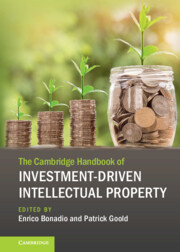Book contents
- The Cambridge Handbook of Investment-Driven Intellectual Property
- The Cambridge Handbook of Investment-Driven Intellectual Property
- Copyright page
- Contents
- Figures and Tables
- Contributors
- Foreword
- Introduction
- I Creativity, Pluralism, and Fictitious Narratives
- Part I Science, Technology and Industry
- II Sui Generis Protection of Non-creative Databases
- III Test Data Exclusivity
- IV Copyright in Works Created by Artificial Intelligence
- V Plant Variety Protection and Investment
- VI Software Protection under Copyright Law
- VII Bilski and the Information Age a Decade Later
- VIII Pharmaceutical Patents and Evergreening
- Part II Culture and Entertainment
- Part III Signs, Images and Designs
VIII - Pharmaceutical Patents and Evergreening
from Part I - Science, Technology and Industry
Published online by Cambridge University Press: 16 March 2023
- The Cambridge Handbook of Investment-Driven Intellectual Property
- The Cambridge Handbook of Investment-Driven Intellectual Property
- Copyright page
- Contents
- Figures and Tables
- Contributors
- Foreword
- Introduction
- I Creativity, Pluralism, and Fictitious Narratives
- Part I Science, Technology and Industry
- II Sui Generis Protection of Non-creative Databases
- III Test Data Exclusivity
- IV Copyright in Works Created by Artificial Intelligence
- V Plant Variety Protection and Investment
- VI Software Protection under Copyright Law
- VII Bilski and the Information Age a Decade Later
- VIII Pharmaceutical Patents and Evergreening
- Part II Culture and Entertainment
- Part III Signs, Images and Designs
Summary
The grant of a patent for a genuinely new chemical entity (NCE) provides for 20 to 25 years protection from generic competition, allowing the patent owner to set prices to recoup the cost of the invention. Evergreening is a strategy by which patent owners extend the life of a patent monopoly, surrounding an original inventive patent with numerous additional patents for modifications or variations to the original invention (secondary patents). The sub-set of secondary patents owned by the originator company are known as ‘evergreening patents’, that is, patents designed to further delay generic entry to the market. Only a small number of evergreening patents achieve this effect. Numerous articles on pharmaceutical marketing consider such patenting an important part of ‘lifecycle management’, ensuring continuing high profits from the original invention are kept ‘evergreen’.
- Type
- Chapter
- Information
- Publisher: Cambridge University PressPrint publication year: 2023

